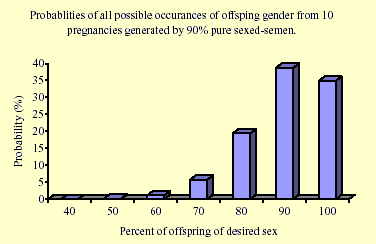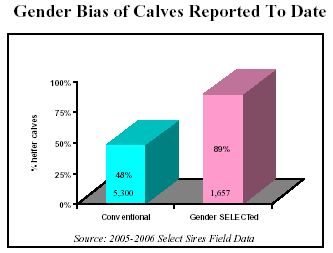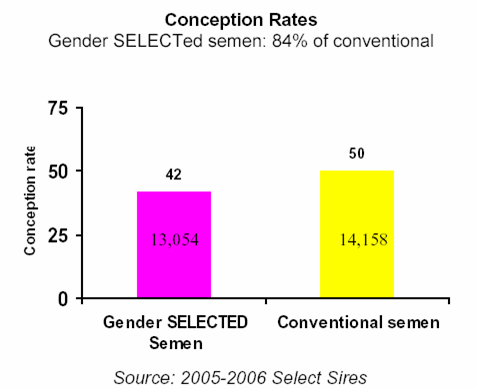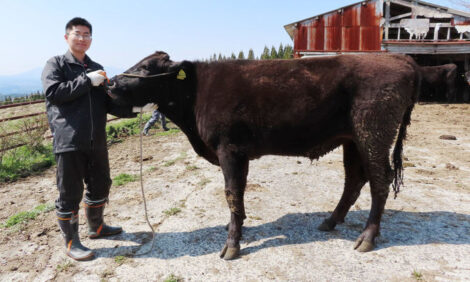



Sexed Semen: Is It Finally a Reality?
Most of us have heard the rumor that sexed semen is “just around the corner” for as long as we have been aware of A.I., writes David Thorbahn, Select Sires Inc., University of Florida IFAS, Dairy Extension.Through the years, countless numbers of techniques have been investigated with no potential application in the real world. However, in the 1980’s a breakthrough in semen sexing technology was made by USDA researchers in the Lawerence Livermore Laboratory in California. The patents for this technology were licensed to a company named XY, Inc of Fort Collins, CO, which performed extensive research during the 1990’s to optimize efficiency of these sorting procedures. In 2001, Select Sires partnered with XY, Inc. to set up field tests on the flow-cytometer processed semen.
Flow-Sorting Technology
One of only a few repeatable techniques to sex sort sperm at a high level of purity uses a device called a flow-cytometer to detect a 3 to 4% difference in DNA content between male and female sperm and sort them with upwards of 90% purity. The first step in this procedure is to dilute sperm to a very low concentration and stain them with a fluorescent dye. The sample is then sent through the flow-cytometer at 60 mph under 30 to 60 psi of pressure. As sperm pass through the internal laser beam, the fluorescent dye is excited. Because of the larger X chromosome, female sperm emit slightly more light than male sperm, which possess the smaller Y chromosome. Detectors measure the amount of fluorescence and assign positive or negative charges to each droplet containing a single sperm. Charged deflector plates then split the single stream into 3 streams: positively charged particles containing one sex go one way, negatively charged particles containing the other sex are deflected in the opposite direction, while uncharged droplets containing multiple sperm or unidentified sex pass straight through. Confirmed with tens of thousands of offspring born in world-wide research trials, the procedure separates sperm of the two sexes with ~90% purity. However, that still leaves 10% of the undesired sex available to compete for fertilization. The table below illustrates the probabilities of all possible occurrences of offspring generated by 90% pure sexed semen.

Commercialization of sexed semen in the U.S. was initiated with a 2003 license granted to Genetic Resources International (GRI) in Navasota, TX. In late 2004, Select Sires partnered with GRI and sent four proven sires to Texas to begin collection and processing of sex-sorted semen. In 2005-2006, Select Sires conducted a nationwide field test and collected information on over 27,000 services. These trials were conducted in a random sample of herds with average or better reproductive efficiency in order to accurately assess product performance for the “average producer.” The resulting calvings have a current data set of nearly 7,000 offspring so far with a gender ratio of 89% heifers when using sexed semen.

Technology Limitations
There are several major limitations that have stifled implementation of sex-sorted semen. Without question, reduced conception rates have been a primary hurdle. As you can imagine from the description above, sex sorting of sperm is a highly invasive procedure that negatively impacts sperm viability and longevity compared to normally cryopreserved semen.

In addition, the procedure is extremely slow and inefficient. To properly sort, sperm must be precisely oriented as they pass through the laser and fluorescence detectors in the flow cytometer. Due to the flat shape of bovine sperm heads, only about 30% are correctly oriented and half of these are female. Thus, only 15% of the sperm going into the machine are recovered as a marketable, sexed product. The high rate of sperm loss precludes use of Select Sires’ “most elite” sires for production of sexed semen.
Although the 3,000 to 5,000 sperm of each sex sorted per second sounds like a lot, this translates into ~1.3 hours of sorting to process enough semen for a standard 20 million sperm/straw dosage. Thus, due to the slow sorting speed, commercialization is only possible with very low sperm numbers per dose (~2 million). If these limitations were not enough, the high cost of flow cytometry equipment (~$250,000 per machine) and intensive amounts of highly skilled labor required to sort sperm dictates that sexed semen will not be inexpensive. Because of the low sperm numbers per dose and compromised sperm viability, Select Sires only recommends its use in well-managed, highly-fertile, virgin heifers. While many research herds have realized very acceptable conception rates, averages indicate well-managed herds that achieve 60 to 65% conception rates in virgin heifers with normal semen can expect 45 to 55% conception rates with sexed semen.
Based on the favorable field results, Select Sires began marketing sexed semen in the fall of 2005. In early 2006, four sorting machines were installed at Select Sires headquarters in Ohio to expand the sexed semen lineup. In the fall of 2006, two additional sorting machines were added to bring the annual production capacity to 350,000 straws. Orders for sexed semen have exceeded our expectations.
What is the return on investment for sexed semen?
The return on investment for the dairy producer depends on a complex interaction between the initial conception rate with non-sexed semen, the percent reduction in conception (if any) due to use of sexed semen, the price differential between sexed and conventional semen, expected gender ratio for sexed vs. conventional, and the value differential between bull and heifer calves. Most of these factors will change considerably from herd to herd, which differentially affects the breakeven value of sexed semen to each respective producer.
To calculate a return on investment (ROI), Select Sires has recently developed a sexed semen calculator in Microsoft Excel format which incorporates more than 20 other variables which will vary from herd to herd. It will assist you in determining how this new opportunity can best be utilized in your individual operation.
Based on the product available today, the best return on investment will be achieved by limiting this product to virgin heifers only and following the “Keys to Success” (see below) to insure optimum probability for conception.
Keys to success
Use of sexed semen will require a breeding gun designed to accommodate the smaller diameter ¼ cc straws. Straws are to be thawed and handled identical to their ½ cc counterparts. However, the smaller diameter and compromised semen quality will make them much more sensitive to cold-shock and errors in semen handling. To maximize potential for success:
- Thaw straws in 95° F water bath for 45 seconds.
- Semen thawing and handling environments should be warm and draft free.
- Warm all semen handling equipment including guns, sheaths, and paper towels prior to contacting straws.
- Only highly experienced technicians should use this product.
- Use only in well-managed, virgin heifers that have achieved greater than 60% of their mature weight by 14 months and in moderate or better body condition.
- Inseminate heifers 8 to 12 hours after observed estrus (AM/PM Rule).
- Use of estrus synchronization and breeding to observed estrus is encouraged, but use of timed-AI in the absence of observed estrus is discouraged.
Other methods of sorting semen
A number of new sex-sorting technologies and companies have recently appeared. Other methods include gender specific antibodies, centrifugation, and free flow electrophoresis. As you evaluate other technologies, please take the time to be wary, and ask numerous questions in order to make informed decisions. If the sex-sorting technology is not based on flow-cytometry and the patents developed by USDA, you should ask for scientific evidence that the procedure can, in fact, sort sperm. Accept nothing short of hundreds of births to assess whether the procedure can effectively produce offspring of the desired sex. Similarly, conception data should be based on thousands of services and should be based on palpated pregnancy data, as simple nonreturn data may mask results and distort the success that can actually be achieved. To date, only flow cytometry provides the best combination of sorting purity and commercial adaptation.
Summary
There is no question sex-sorted sperm for gender selection is now a reality. The product currently offered by Select Sires is backed by over 5 years of extensive field research and has been rapidly accepted by the U.S. marketplace. Currently, 18 of the 23 proven Holsteins and 2 of the 3 Jersey sires in the Select Sires sexed semen lineup have demand that exceeds the supply.
Because of continuing research, there will likely be improvements to the product and there will be the potential to utilize sex-sorted semen on lactating cows but current fertility results indicate its best fit right now is on virgin heifers.
Sources and Credit for Program and Research: Mel DeJarnette MS, Select Sires Senior Reproductive Physiologist, Clifton Marshall MS, Select Sires Vice President of Research and Quality Control; Dr. Ray Nebel PhD, Select Sires Senior Reproductive Physiologist; Dr. Don Monkey DVM, Select Sires Vice President of Operations.
April 2008


